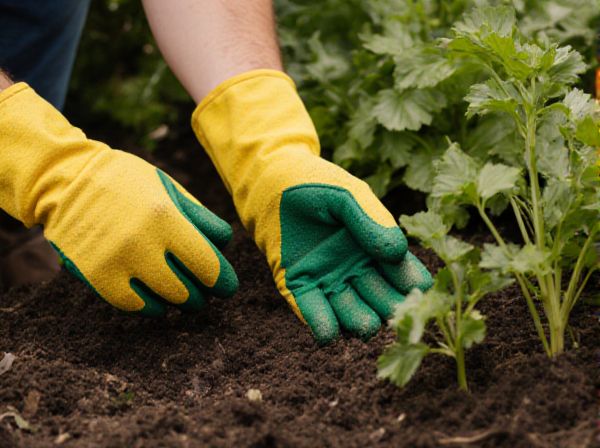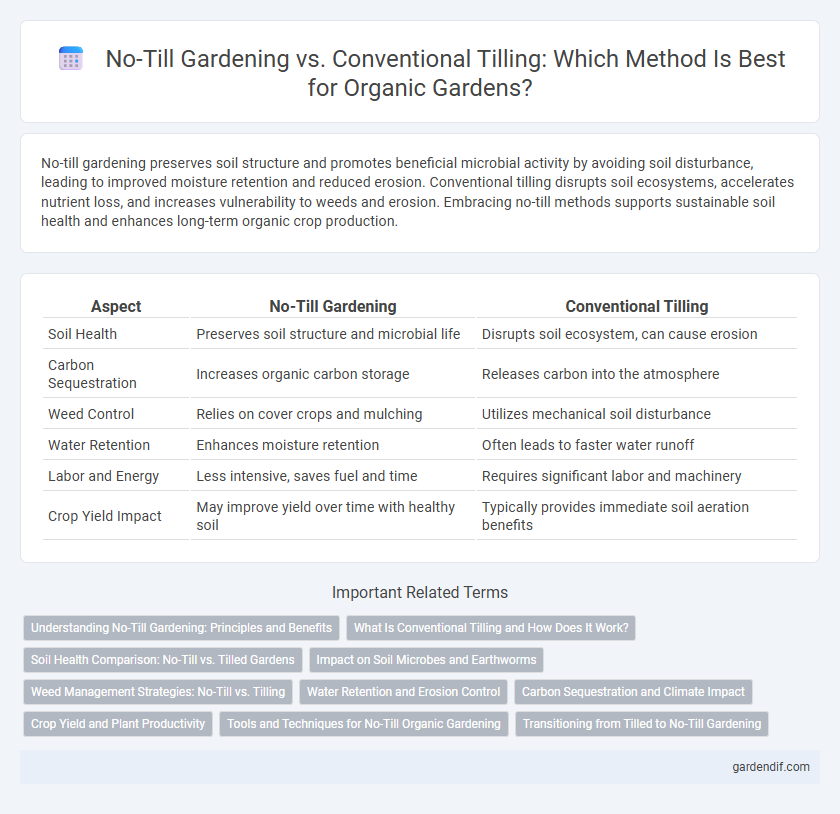
No-till gardening vs Conventional tilling Illustration
No-till gardening preserves soil structure and promotes beneficial microbial activity by avoiding soil disturbance, leading to improved moisture retention and reduced erosion. Conventional tilling disrupts soil ecosystems, accelerates nutrient loss, and increases vulnerability to weeds and erosion. Embracing no-till methods supports sustainable soil health and enhances long-term organic crop production.
Table of Comparison
| Aspect | No-Till Gardening | Conventional Tilling |
|---|---|---|
| Soil Health | Preserves soil structure and microbial life | Disrupts soil ecosystem, can cause erosion |
| Carbon Sequestration | Increases organic carbon storage | Releases carbon into the atmosphere |
| Weed Control | Relies on cover crops and mulching | Utilizes mechanical soil disturbance |
| Water Retention | Enhances moisture retention | Often leads to faster water runoff |
| Labor and Energy | Less intensive, saves fuel and time | Requires significant labor and machinery |
| Crop Yield Impact | May improve yield over time with healthy soil | Typically provides immediate soil aeration benefits |
Understanding No-Till Gardening: Principles and Benefits
No-till gardening minimizes soil disturbance by avoiding traditional plowing, preserving soil structure and promoting beneficial microbial activity. This method enhances water retention, reduces erosion, and increases organic matter, leading to healthier, more resilient plants. Studies show no-till practices improve carbon sequestration and biodiversity compared to conventional tilling.
What Is Conventional Tilling and How Does It Work?
Conventional tilling involves turning and breaking up the soil using machinery such as plows or rototillers to prepare garden beds for planting. This process aerates the soil, controls weeds, and incorporates organic matter or fertilizers evenly throughout the soil profile. However, frequent tilling can disrupt soil structure, reduce beneficial microbial activity, and increase erosion risks compared to no-till gardening methods.
Soil Health Comparison: No-Till vs. Tilled Gardens
No-till gardening preserves soil structure by minimizing disturbance, which enhances microbial activity and organic matter retention, leading to improved soil fertility. In contrast, conventional tilling disrupts soil aggregates, accelerates organic matter decomposition, and increases erosion risks, ultimately degrading soil health. Studies show no-till practices increase earthworm populations and soil moisture content, promoting sustainable crop growth over time.
Impact on Soil Microbes and Earthworms
No-till gardening significantly enhances soil microbial diversity and activity by preserving natural soil structure and organic matter, which creates a stable habitat for beneficial microbes and earthworms. Conventional tilling disrupts soil communities, reduces microbial biomass, and negatively affects earthworm populations by breaking their tunnels and exposing them to predators. Maintaining healthy soil microbes and earthworms in no-till systems improves nutrient cycling, soil aeration, and overall soil fertility critical for organic gardening success.
Weed Management Strategies: No-Till vs. Tilling
No-till gardening suppresses weed growth by maintaining soil structure and organic matter, promoting beneficial microbial activity that naturally inhibits weed seeds. Conventional tilling disrupts weed roots but often brings dormant weed seeds to the surface, leading to increased weed emergence. Integrating cover crops and mulching in no-till systems enhances weed control without disturbing soil integrity, unlike repeated tilling cycles that can degrade soil health over time.
Water Retention and Erosion Control
No-till gardening significantly enhances water retention by preserving soil structure and organic matter, which reduces surface runoff and increases moisture absorption. Conventional tilling disrupts soil aggregates, leading to faster water evaporation and decreased water-holding capacity. No-till practices improve erosion control by maintaining root systems that stabilize soil, preventing topsoil loss during heavy rains compared to the increased susceptibility caused by frequent tilling.
Carbon Sequestration and Climate Impact
No-till gardening enhances carbon sequestration by preserving soil structure and promoting microbial activity, which increases organic matter retention and reduces carbon dioxide emissions. Conventional tilling disrupts soil ecosystems, accelerates organic matter decomposition, and releases stored carbon into the atmosphere, contributing to higher greenhouse gas levels. Implementing no-till practices in organic agriculture significantly mitigates climate impact by maintaining soil carbon stocks and supporting long-term soil health.
Crop Yield and Plant Productivity
No-till gardening enhances soil structure and microbial activity, leading to improved water retention and nutrient availability, which ultimately increases crop yield and plant productivity compared to conventional tilling. Conventional tilling disrupts soil ecosystems, causing erosion and nutrient loss, negatively impacting long-term crop performance. Studies show no-till systems can boost yields by up to 20% while promoting sustainable plant growth and soil health.
Tools and Techniques for No-Till Organic Gardening
No-till organic gardening employs tools like broadforks and hand rakes to aerate soil without disturbing its natural structure, preserving beneficial microbes and earthworms. Techniques such as mulching and cover cropping enhance soil fertility and moisture retention while suppressing weeds, reducing the need for mechanical intervention. This method contrasts conventional tilling, which relies on heavy machinery that can disrupt soil ecosystems and accelerate erosion.
Transitioning from Tilled to No-Till Gardening
Transitioning from conventional tilling to no-till gardening improves soil health by preserving organic matter and enhancing microbial activity. No-till gardening reduces erosion and water runoff, promoting sustainable nutrient cycling and moisture retention. Adopting cover crops and organic mulches supports this transition by stabilizing soil structure and suppressing weeds naturally.
No-till gardening vs Conventional tilling Infographic

 gardendif.com
gardendif.com